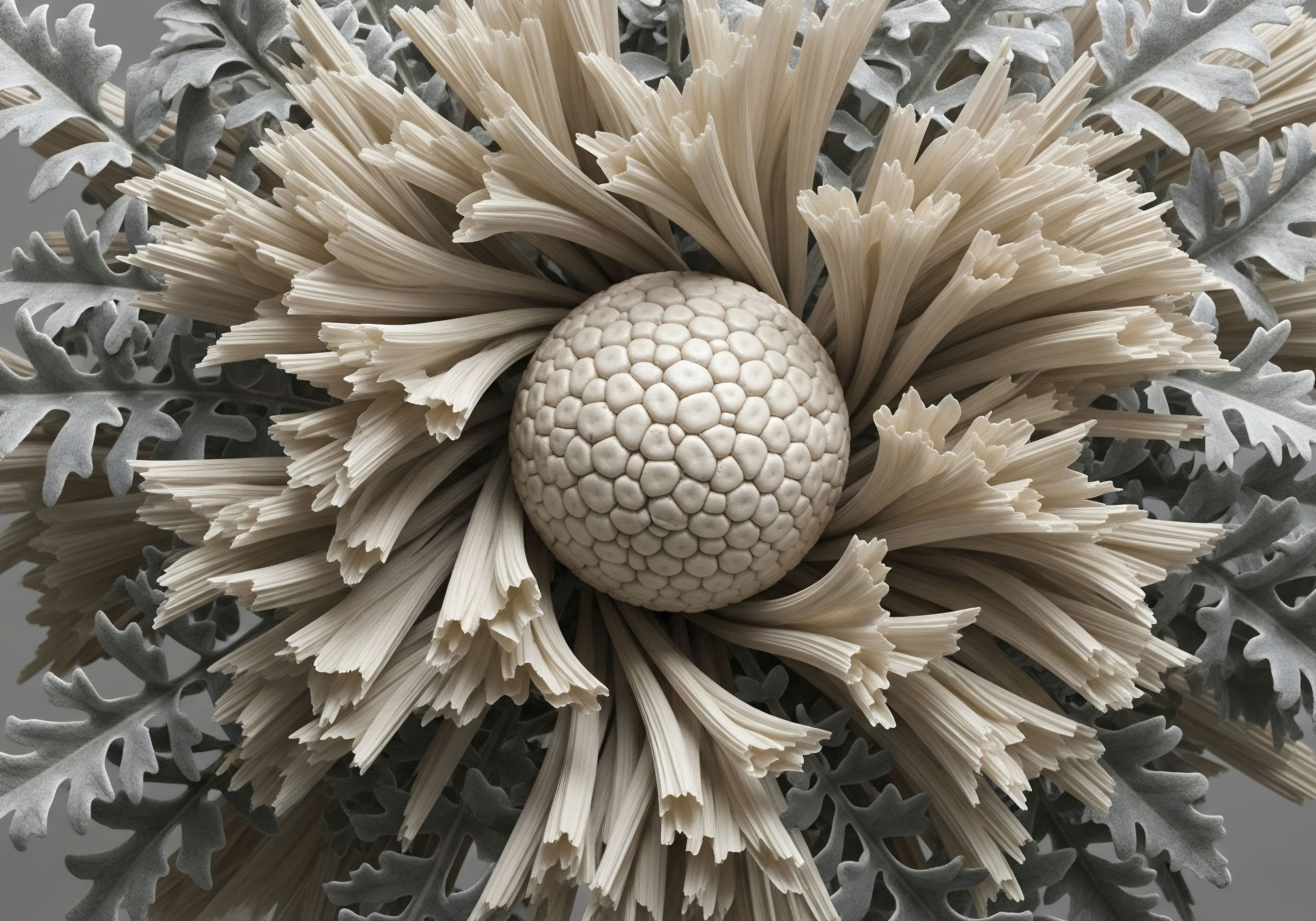

Fundamentals
When you experience shifts in your vitality, perhaps a subtle decline in energy, changes in body composition, or a less restorative sleep, it is natural to seek explanations. These sensations represent a deeper conversation your biological systems are having, particularly within the intricate world of hormonal balance.
Understanding these internal communications is the first step toward reclaiming your full potential. Many individuals find themselves grappling with a sense of diminished capacity, a feeling that their body is no longer responding as it once did. This experience can be disorienting, prompting a desire to comprehend the underlying mechanisms at play.
The body’s endocrine system operates as a sophisticated network of glands and hormones, orchestrating nearly every physiological process. Among these vital messengers, growth hormone (GH), also known as somatotropin, plays a central role in regulating growth, metabolism, and cellular repair throughout life.
While often associated with childhood development, GH remains critically important in adulthood, influencing body composition, bone density, and overall metabolic function. A decline in growth hormone levels, a phenomenon sometimes referred to as somatopause, can contribute to symptoms such as increased body fat, reduced muscle mass, decreased bone mineral density, and a general reduction in vitality. Recognizing these connections allows for a more targeted approach to wellness.
For decades, direct recombinant human growth hormone (rhGH) therapy has been available for diagnosed growth hormone deficiency. A different class of compounds, known as growth hormone secretagogues (GHSs), has gained significant attention. These compounds function by stimulating the body’s own pituitary gland to produce and release more growth hormone, rather than introducing exogenous GH.
This approach aims to work in concert with the body’s natural regulatory mechanisms, promoting a more physiological release pattern of GH. The distinction is important ∞ GHSs encourage your body’s inherent capacity to produce GH, offering a pathway to support your system’s natural rhythms.
Growth hormone secretagogues stimulate the body’s own pituitary gland to produce and release growth hormone, working with natural biological rhythms.
The concept of stimulating endogenous hormone production holds particular appeal for those seeking to optimize their health in a way that respects the body’s innate intelligence. Instead of simply replacing a hormone, these peptides act as biological signals, prompting the pituitary gland to perform its natural function more robustly.
This gentle yet effective stimulation can lead to a cascade of beneficial effects, addressing many of the concerns that arise with age-related hormonal shifts. The goal is to restore a more youthful hormonal environment, allowing the body to function with greater efficiency and resilience.

What Are Peptides and How Do They Influence Growth Hormone?
Peptides are short chains of amino acids, the fundamental building blocks of proteins. They act as signaling molecules within the body, relaying instructions between cells and systems. Their relatively small size allows them to interact with specific receptors, triggering a wide array of biological responses.
In the context of growth hormone protocols, specific peptides are designed to interact with the hypothalamic-pituitary-somatotropic (HPS) axis, the primary regulatory pathway for GH production and release. This axis involves a complex interplay between the hypothalamus, the pituitary gland, and the liver, ultimately influencing the production of insulin-like growth factor 1 (IGF-1).
The hypothalamus, a region of the brain, produces growth hormone-releasing hormone (GHRH), which stimulates the pituitary gland to release GH. Conversely, the hypothalamus also produces somatostatin, which inhibits GH release. The balance between these two hypothalamic hormones dictates the pulsatile secretion of GH from the pituitary.
Peptides used in growth hormone protocols typically work by either mimicking GHRH or by antagonizing somatostatin, thereby tipping the balance in favor of increased GH secretion. This targeted action allows for a precise modulation of the body’s growth hormone system.
A third key player in this regulatory network is ghrelin, a peptide primarily produced in the stomach. Ghrelin is known for its role in stimulating appetite, but it also acts as a potent growth hormone secretagogue, binding to the growth hormone secretagogue receptor (GHS-R) in the pituitary and hypothalamus. Peptides that mimic ghrelin’s action can therefore also stimulate GH release. Understanding these distinct mechanisms provides a clearer picture of how various peptides can influence your body’s hormonal landscape.
The influence of these peptides extends beyond mere growth. They contribute to a more efficient metabolic state, supporting the body’s ability to utilize energy effectively. This can translate into improvements in body composition, with a reduction in adipose tissue and an increase in lean muscle mass.
For individuals seeking to optimize their physical form and function, these peptides offer a promising avenue. The impact on cellular repair and regeneration also contributes to a sense of renewed vitality, allowing for better recovery from physical exertion and daily stressors.


Intermediate
Moving beyond the foundational understanding of growth hormone regulation, we can now explore the specific peptides employed in modern growth hormone protocols and their distinct mechanisms of action. These therapeutic agents are not interchangeable; each possesses unique properties that can be leveraged to achieve particular physiological outcomes.
The selection of a specific peptide or combination of peptides is a precise clinical decision, tailored to an individual’s unique biological profile and wellness objectives. This personalized approach ensures that the intervention aligns with the body’s specific needs, promoting optimal results.

How Do Growth Hormone Releasing Peptides Work?
Growth hormone releasing peptides (GHRPs) represent a class of synthetic peptides that stimulate GH release. They primarily act on the GHS-R, distinct from the GHRH receptor. This dual regulatory system, involving both GHRH and ghrelin pathways, provides multiple points of intervention for modulating GH secretion. The synergy between these pathways can be harnessed to achieve more robust and sustained GH release.
Consider the body’s hormonal system as a finely tuned orchestra. GHRH acts as the conductor, signaling the pituitary to play its part by releasing GH. Somatostatin, on the other hand, functions as a dampener, ensuring the GH release does not become excessive.
GHRPs introduce a new instrument, mimicking ghrelin, which encourages the pituitary to produce more GH, often by overriding the somatostatin’s inhibitory signals. This intricate interplay allows for a sophisticated modulation of the GH axis, promoting a more balanced and rhythmic secretion.
Growth hormone releasing peptides stimulate GH release by acting on the ghrelin receptor, often counteracting somatostatin’s inhibitory signals.
The primary peptides utilized in growth hormone protocols fall into two main categories ∞ Growth Hormone-Releasing Hormone (GHRH) analogues and Growth Hormone Releasing Peptides (GHRPs). Some protocols also incorporate compounds that mimic ghrelin’s action, providing an oral option for GH stimulation. Each category offers distinct advantages and considerations, allowing for a highly customized therapeutic strategy.

Specific Peptides and Their Clinical Applications
Several specific peptides are frequently employed in growth hormone optimization protocols, each with a unique profile of action and clinical utility. Understanding these differences is essential for a precise and effective approach to hormonal recalibration.
- Sermorelin ∞ This peptide is a synthetic analogue of GHRH. It functions by stimulating the pituitary gland to release its own stored growth hormone. Sermorelin’s action is considered more physiological because it preserves the natural pulsatile release pattern of GH, avoiding the constant, supraphysiological levels that can occur with direct GH administration. It is often chosen for its ability to improve sleep quality, reduce body fat, and enhance lean muscle mass.
- Ipamorelin ∞ As a selective growth hormone secretagogue, Ipamorelin mimics the action of ghrelin, binding to the GHS-R. Its selectivity means it stimulates GH release with minimal impact on other hormones like cortisol, prolactin, or ACTH, which can be a concern with some other GHRPs. This makes Ipamorelin a preferred choice for those seeking the benefits of GH stimulation without unwanted side effects such as increased appetite or elevated stress hormones. It is valued for its effects on muscle growth, fat reduction, and significant improvements in sleep architecture, particularly slow-wave sleep.
- CJC-1295 ∞ This GHRH analogue is known for its long-acting properties due to its ability to bind to albumin in the blood, extending its half-life. When combined with Ipamorelin, CJC-1295 provides a sustained release of GH, leading to consistently elevated levels of both GH and IGF-1. This combination is frequently used to promote muscle protein synthesis, decrease adipose tissue, and improve overall recovery. The extended action of CJC-1295 reduces the frequency of administration, enhancing patient convenience.
- Tesamorelin ∞ Another GHRH analogue, Tesamorelin has demonstrated particular efficacy in reducing visceral adipose tissue, especially in specific patient populations such as those with HIV-associated lipodystrophy. Its targeted action on fat metabolism makes it a valuable tool for body recomposition, contributing to a healthier metabolic profile. Tesamorelin also supports the natural pulsatile pattern of GH release, similar to Sermorelin.
- Hexarelin ∞ This potent GHRP stimulates GH release significantly. While effective, it can lead to an increase in prolactin and cortisol levels in some individuals. Beyond its GH-releasing properties, Hexarelin has been studied for its direct cardioprotective and cytoprotective effects, suggesting benefits independent of its impact on the somatotropic axis.
- MK-677 (Ibutamoren) ∞ Distinct from the injectable peptides, MK-677 is a non-peptide ghrelin mimetic that can be administered orally. It acts on the GHS-R to stimulate GH and IGF-1 secretion. MK-677 is recognized for its substantial effects on increasing GH levels, improving sleep quality, enhancing muscle mass, and reducing body fat. Its oral bioavailability offers a convenient alternative for individuals seeking to support their growth hormone axis.
The choice among these peptides depends on a comprehensive assessment of an individual’s health status, specific symptoms, and desired outcomes. For instance, someone prioritizing sleep improvement and lean mass gain with minimal side effects might consider Ipamorelin, perhaps combined with CJC-1295 for sustained action. Conversely, an individual with significant visceral fat accumulation might find Tesamorelin a more targeted option.

Protocols and Administration Considerations
Growth hormone peptide therapy protocols are highly individualized, taking into account factors such as age, baseline hormone levels, and specific health objectives. Administration typically involves subcutaneous injections, often performed at home, or oral administration for compounds like MK-677. The timing of administration is often crucial to synchronize with the body’s natural GH pulsatility, such as before bedtime to align with the largest natural GH pulse during sleep.
Monitoring involves regular blood tests to assess levels of IGF-1, which serves as a reliable indicator of GH activity, along with other relevant biomarkers. Adjustments to dosage and frequency are made based on these laboratory results and the individual’s clinical response. The aim is to achieve optimal physiological levels, avoiding both deficiency and excess, thereby maximizing benefits while minimizing potential adverse effects.
Here is a general overview of common peptide pairings and their primary applications ∞
| Peptide Combination | Primary Mechanism | Key Benefits |
|---|---|---|
| Sermorelin | GHRH analogue, stimulates pituitary GH release | Improved sleep, body composition, muscle recovery, anti-aging |
| Ipamorelin + CJC-1295 | GHRP + Long-acting GHRH analogue, synergistic GH/IGF-1 release | Significant muscle gain, fat loss, deep sleep enhancement, accelerated recovery |
| Tesamorelin | GHRH analogue, targeted fat reduction | Visceral fat reduction, metabolic health improvement |
| MK-677 (Oral) | Ghrelin mimetic, oral GH/IGF-1 secretagogue | Muscle growth, fat loss, profound sleep improvement, convenience |
The careful titration of these peptides, guided by clinical expertise and objective data, allows for a precise recalibration of the somatotropic axis. This methodical approach helps individuals regain a sense of hormonal equilibrium, translating into tangible improvements in their daily lives.


Academic
A deep exploration into the specific peptides used in growth hormone protocols necessitates a rigorous examination of their molecular mechanisms and their intricate interplay within the broader neuroendocrine landscape. The effectiveness of these agents stems from their precise interactions with cellular receptors and signaling pathways, ultimately modulating the hypothalamic-pituitary-somatotropic (HPS) axis. This systems-biology perspective reveals how targeted peptide interventions can recalibrate complex physiological functions, moving beyond simplistic notions of hormone replacement.

Molecular Mechanisms of Growth Hormone Secretagogues
The regulation of growth hormone (GH) secretion is a tightly controlled process involving a dynamic balance between stimulatory and inhibitory signals originating from the hypothalamus. The primary stimulatory signal is growth hormone-releasing hormone (GHRH), a 44-amino acid peptide that binds to the GHRH receptor (GHRH-R) on somatotroph cells in the anterior pituitary.
This binding activates the adenylate cyclase-cAMP-protein kinase A pathway, leading to increased GH synthesis and release. The inhibitory signal, somatostatin (SST), acts via specific somatostatin receptors (SST-Rs) on somatotrophs to suppress GH secretion by inhibiting adenylate cyclase and reducing calcium influx.
Growth Hormone Releasing Peptides (GHRPs), such as Ipamorelin and Hexarelin, operate through a distinct mechanism. They bind to the growth hormone secretagogue receptor (GHS-R1a), a G-protein coupled receptor primarily located in the pituitary and hypothalamus. The endogenous ligand for GHS-R1a is ghrelin, a 28-amino acid acylated peptide predominantly produced by the stomach. Activation of GHS-R1a by GHRPs or ghrelin leads to an increase in intracellular calcium, which synergizes with GHRH signaling to potentiate GH release.
The synergistic action of GHRH analogues and GHRPs is a cornerstone of advanced growth hormone protocols. GHRH analogues, like Sermorelin and Tesamorelin, directly stimulate the GHRH-R, increasing the pool of GH available for release. GHRPs, by activating GHS-R1a, not only promote GH release but also counteract the inhibitory effects of somatostatin, effectively disinhibiting the somatotrophs. This dual action results in a more robust and sustained pulsatile release of GH, closely mimicking the physiological pattern observed in younger individuals.
The synergistic action of GHRH analogues and GHRPs promotes a robust, sustained, and pulsatile release of growth hormone.

Interplay with Metabolic Pathways and Neurotransmitter Function
The influence of growth hormone and its stimulating peptides extends far beyond simple anabolic effects, deeply integrating with metabolic pathways and even neurotransmitter systems. GH itself has a complex relationship with insulin sensitivity and glucose homeostasis. While GH promotes lipolysis (fat breakdown) and can increase insulin resistance at higher, supraphysiological levels, its physiological pulsatile release, stimulated by peptides, aims to optimize metabolic function without adverse effects.
For instance, MK-677 (Ibutamoren), a non-peptide ghrelin mimetic, has demonstrated significant effects on sleep architecture, specifically increasing the duration of stage 4 (deep) sleep and REM sleep. This improvement in sleep quality is critical for natural GH secretion, as the largest GH pulses occur during deep sleep.
By enhancing sleep, MK-677 indirectly supports the body’s endogenous GH production, creating a positive feedback loop for overall vitality. The ghrelin system itself is also implicated in reward processing and memory, suggesting broader neurological impacts beyond appetite regulation.
The impact on body composition is mediated not only by direct GH action but also by Insulin-like Growth Factor 1 (IGF-1), which is primarily produced in the liver in response to GH stimulation. IGF-1 mediates many of the anabolic effects of GH, including protein synthesis and cellular proliferation in muscle and bone.
The precise regulation of the GH/IGF-1 axis by these peptides ensures that these anabolic processes are supported, contributing to lean muscle mass accretion and reduction of adipose tissue.
Furthermore, the GHS-R is expressed in various peripheral tissues, including the cardiovascular system, gastrointestinal tract, and immune cells. This widespread distribution suggests that GHRPs may exert direct effects on these systems independent of their GH-releasing activity. For example, Hexarelin has shown direct cardioprotective properties, improving cardiac function in ischemic conditions, which highlights the pleiotropic actions of these peptides beyond their endocrine roles. This broader physiological impact underscores the systemic benefits of carefully applied peptide protocols.

Clinical Evidence and Future Directions
Clinical trials have explored the efficacy and safety of these peptides in various contexts. Tesamorelin, for example, is FDA-approved for reducing visceral fat in HIV-associated lipodystrophy, demonstrating its targeted metabolic effects. Studies on Sermorelin and other GHRPs have shown increases in GH and IGF-1 levels in both adults and children with GH deficiency, leading to improvements in body composition, exercise capacity, and quality of life.
While direct recombinant GH therapy carries risks such as glucose intolerance and potential tumor recurrence, GHSs, by promoting pulsatile GH release, may mitigate some of these concerns. The body’s natural negative feedback mechanisms remain intact, preventing supraphysiological GH levels. However, long-term, rigorously controlled studies on the safety and efficacy of GHSs for anti-aging or performance enhancement are still ongoing.
The ongoing research into novel peptide structures and delivery methods continues to expand the therapeutic landscape. The potential for orally active compounds, like MK-677, offers increased convenience and adherence. As our understanding of the HPS axis and its broader systemic connections deepens, the application of specific peptides will become even more refined, offering increasingly personalized and effective strategies for optimizing human vitality and function.
| Peptide Type | Primary Receptor Interaction | Key Physiological Outcomes |
|---|---|---|
| GHRH Analogues (Sermorelin, Tesamorelin, CJC-1295) | GHRH Receptor (GHRH-R) on pituitary somatotrophs | Increased GH synthesis and pulsatile release, IGF-1 production, lipolysis, muscle protein synthesis, improved sleep |
| GHRPs (Ipamorelin, Hexarelin) | Growth Hormone Secretagogue Receptor (GHS-R1a) in pituitary and hypothalamus | Potent GH release (synergistic with GHRH), somatostatin antagonism, direct tissue effects (e.g. cardioprotection) |
| Ghrelin Mimetics (MK-677) | GHS-R1a (oral activation) | Significant GH/IGF-1 increase, enhanced deep sleep, appetite modulation, body recomposition |
The scientific community continues to explore the full spectrum of these peptides’ actions, including their roles in tissue repair, inflammation modulation, and cognitive function. This ongoing inquiry promises to further refine our ability to leverage these biological messengers for comprehensive wellness.

References
- Ishida, J. Saitoh, M. Ebner, N. Springer, J. Anker, S. D. & von Haehling, S. (2020). Growth hormone secretagogues ∞ history, mechanism of action, and clinical development. JCSM Rapid Communications, 3(1), 25-37.
- Walker, R. F. (2006). Growth hormone-releasing peptides. Clinical Pharmacology & Therapeutics, 80(5), 403-411.
- Falutz, J. Allas, S. Blot, K. et al. (2007). Metabolic effects of a growth hormone-releasing factor in patients with HIV. The New England Journal of Medicine, 357(23), 2359-2370.
- Bercu, B. B. & Root, A. W. (Eds.). (1998). Growth Hormone Secretagogues in Clinical Practice. CRC Press.
- Mayo, K. E. (1992). Molecular cloning and expression of a pituitary-specific receptor for a hypothalamic growth hormone-releasing hormone. Nature, 356(6369), 430-434.
- Kojima, M. Hosoda, H. Date, Y. Nakazato, M. Matsuo, H. & Kangawa, K. (1999). Ghrelin is a growth-hormone-releasing acylated peptide from stomach. Nature, 402(6762), 656-660.
- Jorgensen, J. O. L. & Juul, A. (2018). Therapy of endocrine disease ∞ growth hormone replacement therapy in adults ∞ 30 years of personal clinical experience. European Journal of Endocrinology, 179(1), R47-R56.
- Sevigny, J. J. Ryan, J. M. van Dyck, C. H. Peng, Y. Lines, C. R. & Nessly, M. L. (2001). Effect of alendronate and MK-677 (a growth hormone secretagogue), individually and in combination, on markers of bone turnover and bone mineral density in postmenopausal osteoporotic women. The Journal of Clinical Endocrinology & Metabolism, 86(3), 1116-1125.
- Argente, J. (2008). Growth Hormone-Releasing Peptides ∞ Clinical and Basic Aspects. Hormone Research, 46(4-5), 1996.
- Popovic, V. & Leal-Cerro, A. (2019). The Safety and Efficacy of Growth Hormone Secretagogues. Frontiers in Endocrinology, 10, 1-8.
- Delhanty, P. J. & van der Lely, A. J. (2011). Ghrelin and its role in therapeutics. European Endocrinology, 7(2), 90-95.

Reflection
Understanding the intricate dance of your body’s hormonal systems, particularly the somatotropic axis, is a powerful step on your personal health journey. The insights gained into specific peptides and their mechanisms offer a pathway to recalibrate your internal environment, supporting vitality and function. This knowledge is a tool for self-discovery, allowing you to interpret your body’s signals with greater clarity.
As you consider these possibilities, reflect on how your own experiences align with the biological narratives presented. What aspects of your well-being could benefit from a more optimized hormonal landscape? The path to reclaiming vitality is deeply personal, requiring thoughtful consideration and expert guidance. This exploration serves as a foundation, encouraging you to engage with your health proactively and seek tailored solutions that honor your unique biological blueprint.

How Can Personalized Protocols Support Longevity?
The pursuit of longevity extends beyond merely extending lifespan; it encompasses enhancing healthspan, ensuring years lived are years lived with quality and vigor. Personalized growth hormone peptide protocols, by optimizing the somatotropic axis, contribute to this goal by supporting cellular repair, metabolic efficiency, and lean tissue maintenance. This proactive approach to hormonal balance can mitigate age-related decline, preserving physical and cognitive function.

What Role Do Lifestyle Factors Play in Peptide Therapy Outcomes?
While peptide therapy offers targeted hormonal support, its effectiveness is significantly amplified when integrated within a holistic wellness strategy. Lifestyle factors such as nutrition, exercise, stress management, and sleep hygiene are not merely complementary; they are foundational. A balanced diet provides the building blocks for hormone synthesis, regular physical activity enhances cellular responsiveness, and adequate, restorative sleep is paramount for natural growth hormone secretion. These elements collectively create an environment where peptide interventions can yield their most profound benefits.



